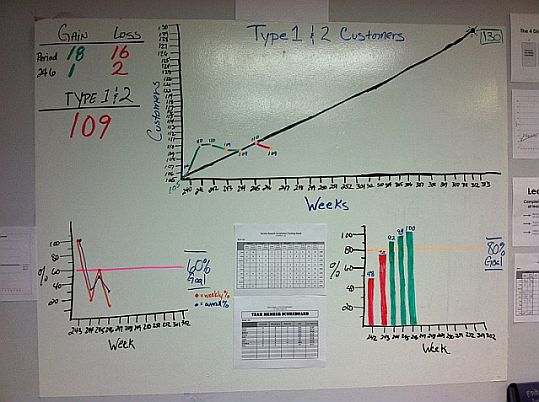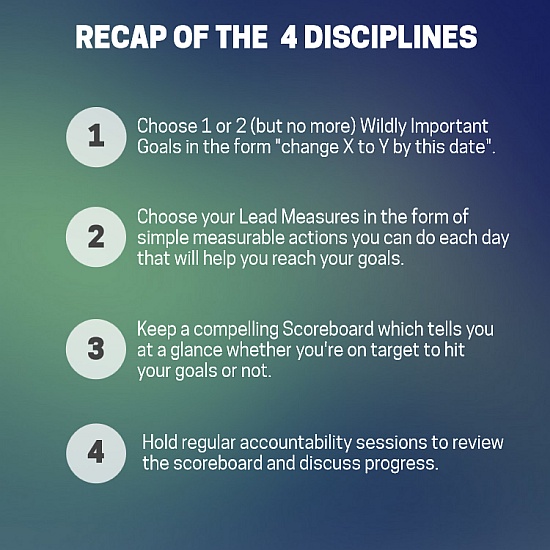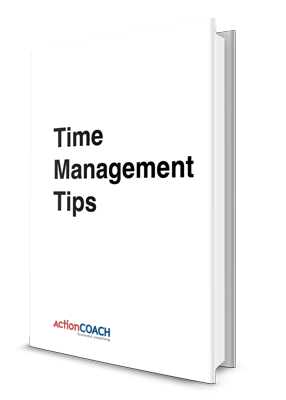Why We Love The 4 Disciplines Of Execution!
Does your organisation kick-start new initiatives only to watch them fizzle out and disappear in just a few months? Do you find yourself swamped with endless projects and struggling to find the time to do justice to each one? If the answer to any of these questions is ‘yes’, it could be time for your business to implement the 4 Disciplines of Execution (4DX for short).
This highly influential strategy created by Sean Covey and his colleagues outlines a winning method for businesses of all shapes and sizes to increase the chances of success when starting new projects.
We’re huge fans of the 4DX method and recommend this kind of approach to all our clients. You can grab your copy of the book over at Amazon and we highly recommend you read it cover to cover to really get to grips with the ideas inside.
For now, we’ll introduce you to the basics principles; it all begins with establishing wildly important goals.
Wildly Important Goals – WIGs
Every business has goals; they may be to increase turnover, generate new customers, improve customer return rates or anything else that leads to a more successful business. The problem is that most businesses have far too many goals at one time, meaning that each member of the team is stretched far beyond capacity.
In order to get the best results from each project, a business must establish its WIGs – Wildly Important Goals. These are the goals that are of paramount importance to the business, beyond everything else.
Your WIGs will become an integral part of your organisation; they will influence the way in which your team functions, the way you interact with clients, and the way you generate profits.
The Whirlwind
The biggest roadblock in achieving your goals is the daily whirlwind: answering emails, attending meetings, dealing with clients, answering phone calls and any number of other small yet frequent daily distractions.
The problem with the whirlwind is that it’s urgent; certain tasks and problems understandably have to be dealt with immediately and must take priority over other work, no matter how important that other work may be.
That’s why it’s so important to keep WIGs to a minimum, in order to give all team members the chance to work on new projects alongside the whirlwind.
Discipline 1 – Focus on the Wildly Important
Establish a finish line
A goal simply isn’t a goal unless it has a measurable result. In order to drive productivity towards that goal, all individuals involved must be aware of the result and the due date of that result. For example, instead of “increase client return rate”, make it “increase client return rate by 30% by end of Q3.”
Start saying no
Successful entrepreneurs tend to be creative and ambitious types, which is why there are often so many ideas and projects going on all at once. It’s important to learn how to say no to most of these ideas, no matter how good they seem. It doesn’t mean you have to dismiss an idea outright; instead, just put a pin in it until you’re ready to give it the time it deserves.
Focus the entire organisation
Each team within your business should focus on no more than two WIGs at any one time. This will keep each team member and leader highly focused on the important tasks at hand. It’s also important that senior leaders do not dictate WIGs, but instead allow team members to get involved in the decision-making process so that they feel passionate and committed to their goals.
Discipline 2 – Acting on Lead Measures
Many long-term business plans are rigid; they have every detail set in stone and are not adaptable. Discipline 2 is designed to allow your business plan to adapt based on the changing needs of your company. Each day and week, the team will identify actions that are most important in driving ‘lead measures’ forward.
At this point I need to stop and explain a bit of terminology because it’s important to understand the difference between lead measures and lag measures.
– Lead measures are things that are predictive and can be influenced.
– Lag measures are statistics that measure the goal.
Let’s say your WIG is to increase turnover from £1m to £1.5m by 31st December. A lag measure of this goal would be the number of sales made in the month of August, but a lead measure would be promotional offers run during the month of August.
Notice that the lead measure could both predict and influence the number of sales in August, whereas the lag measure just records something after it’s happened.
There’s no harm in monitoring lag measures along the way, but remember that once the numbers are in it’s already too late to change them. Lead measures, on the other hand, tell you what actions you need to take right now in order to hit your Wildly Important Goals.
Discipline 3 – The Compelling Scoreboard
Every business has a scoreboard, or series of scoreboards, to keep an eye on their progress. But discipline 3 requires you to create a scoreboard like no other – one that actively engages team members to fulfil your Wildly Important Goals.
A compelling scoreboard should be easy to read and understand, so that with a quick glance each member of the team understands whether or not they’re on track towards their WIGs.
Both lag and lead measures will be included in the scoreboard, but they will be presented in a way that means something to the team members working towards the WIG and not just the business leaders.
It won’t simply be a barrage of data, but a few clear graphs, charts and statistics to show the team, at this given moment, whether they’re on course to hit their WIGs or not.
Discipline 4 – Accountability
Disciplines 1 to 3 provide the focus, clarity and engagement needed to succeed in your business goals, but discipline 4 establishes accountability to ensure that the goals are achieved, no matter what.
4DX recommends holding accountability sessions at least once each week to discuss progress. The meetings don’t have to be long – no more than 15 or 20 minutes – but it is important that they occur at the same time each week with a set agenda in order to reinforce accountability on a regular basis. These sessions help each individual to stay focused, uncover any roadblocks and keep the team moving forwards at a steady pace.
You’ll want to cover the same topics each week, including a review of the compelling scoreboard (see Discipline 2) and a discussion of any actions you plan on taking to improve the lead measures for the next session.
Summary
Here’s a recap of the 4 disciplines…
- Choose 1 or 2 (but no more) Wildly Important Goals in the form “change X to Y by this date”
- Choose your Lead Measures in the form of simple measurable actions you can do each day that will help you reach your goals
- Keep a Compelling Scoreboard which tells you at a glance whether you’re on target to hit your goals or not
- Hold regular accountability sessions to review the scoreboard and discuss progress
Is Your Business Ready for 4DX?
We believe that every business, no matter how big or small, could benefit from the principles in The 4 Disciplines of Execution, so if you only invest in one business coaching book this year, make sure it’s this one.
Master Time Management
In This Free Ebook + Email Course You Will Learn How to:
Create the Optimum Working Environment
Manage Your Energy Better
Prioritise Effectively








